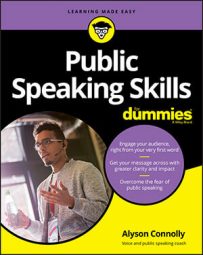When I started out acting, I got a weird bit of direction. A director once told me that I was pushing myself on the other actor, specifically with my chin and neck. I looked around: There was a solid three feet around me and the other player. A total personal bubble. No pushing in sight. “No need to force yourself on him!” the director shouted, as I stood in the corner of the stage by myself, and the other actor was at the front. “It’s a quiet scene!”
What was the director talking about? And what was I doing wrong? I should have clued in when he was talking about the intimacy of the scene. Many people who are inexperienced performers tend to push their voices too hard, at all times. They go full tilt, regardless of the tone of the speech. I learned that day that when there is a quiet scene, it’s okay to act appropriately quiet. What we want to hear in a speaker is one who speaks with ease, not one who is turning red, is tense all over, and looks like he’s gonna blow.
Disconnect your thoughts and feelings
What does pushing do to your message? Sure, you may feel the emotion, but you’re only using one way to express it. The quiet, the soft — it all goes away. It’s like the so-called “loudness wars” in music. In the past few decades, there’s been a push to engineer popular music to be as loud as it possibly can go on a recording, presumably to grab attention on the radio. All the frequencies are boosted and compressed, which undercuts the difference between the soft parts and the loud parts. What this has done is flatten the dynamics, and make recorded music sound much more monotonous, all the way through a song. You don’t have the change in tone from the acoustic part in Led Zeppelin’s “Stairway to Heaven” to the heavier parts. When those differences are gone, the differences in emotion go away along with it.Speech works the same way. When I listen to someone who is pushing, whether it be at a dinner party or at a presentation, it all sounds the same. There are none of those ridges and valleys, those emotional leaps you get when volume or tone changes. The audience is there for the content of the speech, but they want the content to provide that emotion, too, and the emotion often comes from the performance itself. At the very least, the dynamics of the performance enhance the emotion in the content.
Wingin’ it
I know nothing about football. If someone were to ask me to describe the mechanics of the game, chances are I would take a deep breath, gather some courage, throw my chest out, and start talking in a really loud voice to muddle my way through it. For some reason, our brains tell us that these things compensate for knowledge.We push when we’re not prepared or when we lack confidence in what we’re saying. For example, if you’re giving a speech about the benefits of vitamin D, you’d better believe it yourself. (Some devoice when they’re unprepared, not wanting anyone to hear what they haven’t worked on.) Ever been to a school council meeting when the president unexpectedly asks the chair of the playground committee to give an update? First the committee chair says, “My apologies, I wasn’t prepared for this.” (Never say sorry or give an excuse, by the way.) But then guess what happens? The chair starts talking loudly. Another example is when comedians are bombing. They’ll push and push until they get anything out of the audience.

